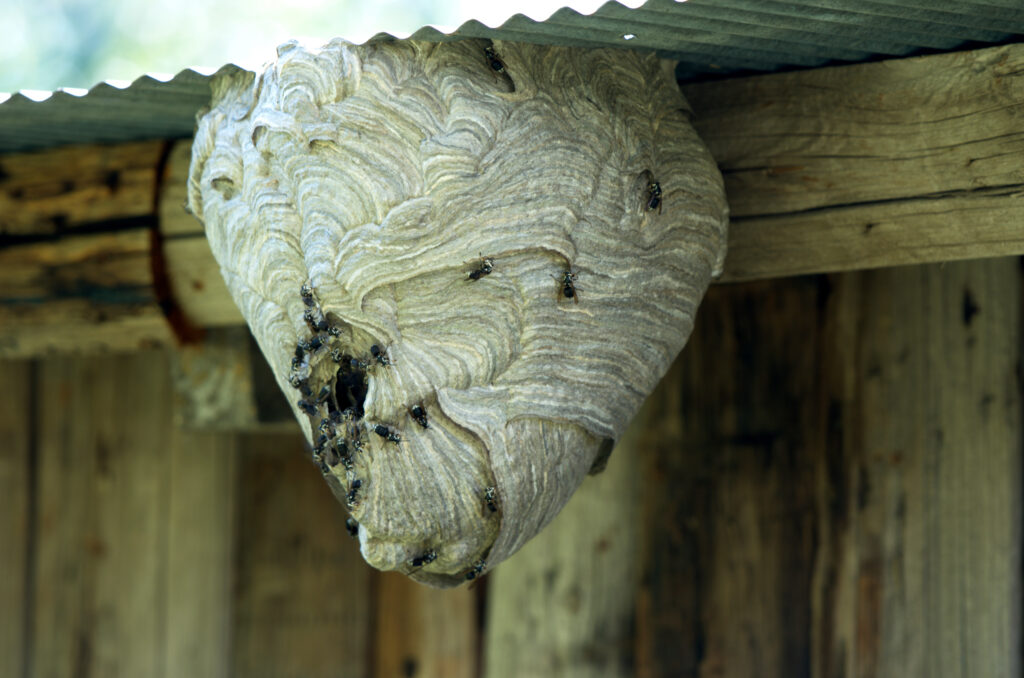Bald-Faced Hornets
Just this week, one of our techs was called to deal with a major problem… a huge, basketball-shaped nest of bald-faced hornets in a local homeowner’s garage. Does that sound like the stuff of nightmares? Yeah, for me too!

The Bald-faced Hornet (sometimes called the white-faced hornet), is actually closely related to yellow jackets. They are known for the white markings on the front of the head and tip of the abdomen with black completing their sheik stylish look. They have a stoutly built body and have large antennae that stand out to observers…assuming you want to observe that closely.
Most people know them by their home-building skills. Their impressive insect condos can actually reach 3 feet tall. During the spring, the queen collects materials made of wood-like fibers to create her nest. This material can come from a building or a fence or any other wooden structure. It is grayish in color and is usually found hanging from a tree or the eave of a structure (such as our earlier discussed customer’s garage). The crafty queen chews the wooden fibers and mixes her saliva to make the paper cells that somewhat resemble a honeybee’s comb. There are usually 3 to 4 levels of combs found within the thick outer layer. Workers come in and out of the entrance located at the bottom of the nest. And for those of you who enjoy moving frequently, this insect lady abandons her home every year to begin a fresh new home for the next season.
The bald-faced hornet can be found all throughout North America but enjoys our southern climate the best. Aphids and caterpillars are favorite foods along with nectar and pollen from nearby flowering plants. The crazy thing about these guys, like their yellow jacket cousins, is they will go for a good steak if it’s available. Seriously though, they do like meat.
Social insects live in large colonies consisting of one queen, workers, and drones. The queen is actually the only one who survives the winter. Part of her job description is to find a good location for the nest, create a small nest, and begin the work of raising the offspring. The first offspring are sterile females whose task is to continue building and maintaining the nest. Now the queen can function in her main duty laying hundreds of eggs for the colony. Strangely, she sometimes does not fertilize some of the eggs. These eggs will become male drones and have only half as many genes as the rest of the gang. The male drones are to be ready to fertilize the queen. The workers maintain the nest and feed the colony. It takes every bald-face to make the colony function efficiently.
When the colony is full-grown, it contains one queen, 200-400 infertile workers, and later in the season males and reproductive females hatched from the eggs laid in the spring.
Now, what about that sting? Social wasps sting to protect their home. If you see one of these large nests, you will likely notice the insects at the entrance. These bald-faced hornets are protecting the entrance and will attack if a perceived threat gets close to the nest. The venomous fluid is injected underneath the victim’s skin with a smooth stinger. Unlike honey bees, these insects are quite capable of stinging more than once and will not leave the stinger embedded in the skin. It is the females who sting, while the male drones are not able to do so. That’s right, fear the mighty female!
As with all insects, bald-faced hornets can be dangerous and require a professional to safely protect your home and property. Canton Termite gets multiple calls each season to deal with these and other flying bees and wasps. If you find yourself facing one of these massive nests of terror, give us a call at 770-479-1598. We are here for you and for your family!
By: Robin
